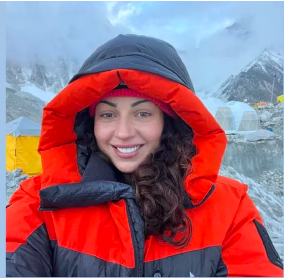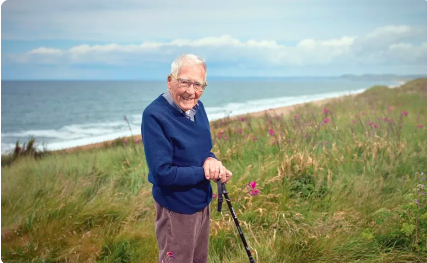On the shoulders of giants
I read today that American-Ukrainian mountaineer Anna Gutu has died along with her guide, Migmar Sherpa in an avalanche on Shishapangma – a 8,027m peak. She was aiming to be the first American woman to summit all 14 peaks over 8,000m.
Migmar was working for a commercial guiding company called Elite Exped, run by internationally renowned mountaineer Nimsdai Purja and his business partner.

This story had deep resonance with me. I’m not a mountaineer and never will be – I climb cliffs in temperate and tropical places. My mind and body have no business being in extreme cold. That’s another story, which I’ll talk about sometime...
The relevance for me comes because I have just finished editing the final chapter of mountaineer Jerry Gore’s biography. In his 45-year career climbing peaks and big walls in extreme locations, he has only participated in one commercial expedition. He speaks eloquently about the experience of being part of a ‘team’ that comprised experienced mountaineers in the form of himself, his climbing partner and the hired guides; and a group of clients including a Saudi prince and his wife, and several other inexperienced climbers. He was troubled by the lack of experience, and amazed that these people are still able to climb these giant – hitherto almost inaccessible – peaks.
I am also reading the rather wonderful ‘Touching my Father’s Soul’ book by Jamling Tenzing Norgay (son of Tenzing Norgay – the first person to summit Everest, along with Edmund Hillary). It’s about his experience climbing Mount Everest in 1996 with the IMAX film crew. Eight people died on the descent while Jamling was on the mountain, and he was part of the rescue attempt. His views about many clients on commercial expeditions are dim in the extreme.
The general impression I get is that rich clients are actually endangering lives. The lives of the guides, of others on the mountain and of the sherpas, as they push harder and harder to get their notch on the bedpost of summitting glory. Many of them have never climbed in a real sense at all. All they have to do is put one foot in front of the other, following the lead of their guides. Food, shelter and the very best in expedition clothing are all taken care of. Many of them don’t even have to take the time to acclimatise, being able to use special oxygen-depleted chambers to get their bodies used to the change in air quality.

I skimmed through Anna Gutu’s Instagram account. She’s a party girl and newly qualified pastry chef who climbed her first mountain in 2022. Her posts are full of inspirational quotes and pouty lips. High heels and short skirts. ‘Anyone can do it’ is her mantra. It is easy to disparage her. To think – that woman has no business being up there in the Death Zone, where a tiny mistake can kill you. I find myself irritated by this woman with her plastic features and makeup and fancy clothes.
[NB Gutu's Insta account has since been altered - less of the heels and pouts, more of the mountaineering pics]
But she died in an avalanche. Mountaineering skills or no, she would have died anyway. Her guide died, too. You can’t question his skills or experience. Many, many of the world’s most competent mountaineers have died, not through lack of skills, but because they have chosen to engage with an activity that takes them into potentially fatal extremes.
So, what is it that gets under my skin? What is it that pisses me off when I look at giant queues of climbers snaking along ridgelines of the world’s most inaccessible peaks?
As ever, it is capitalism. It’s the fact that people will do anything for money. Whether it’s the governments taking their cut or the local population who depend on the input of cash. Who is willing to sacrifice a potential stream of money for the safety of other people, or for the preservation of the environment?
It is yet another perfect framed example, a microcosm of what happens everywhere on this planet. Exploration is swiftly followed by domination and destruction.
I thought about the chapter in 'Sapiens' where Harari describes the effect that homo sapiens had on local environments: everywhere our species appeared on this planet, there quickly followed extinction events and ecological disasters. We are a destructive force. On a small scale, it is simply a fact of life on Earth. Ecosystems are constantly adapting and re-adjusting to change, whether it's climate or dominant species. For many millennia, this re-calibration has happened seamlessly. A species dies out, and the ecosystem it was part of re-establishes a new balance; new predators, new diseases, new challenges in access to resources that keep everything in check and ensure that there is always enough.
On a larger scale, those ecosystem re-calibrations will probably continue to happen (hopefully), but they will come with giant cost to life (flora and fauna and humanity itself). Since I was a teen, I have been a fan of James Lovelock's theory of Gaia: the Earth being a self-regenerating, constantly rejuvenating thing.

But going back to the matter in hand. We humans must self regulate: on an individual level and on a social, macro level. How do we prevent an increase in deaths on the mountains? Do we even need to? The big picture says no. The tiny minority of people who climb those 8,000-metre mountains are just that. They have no real impact on life on Earth, nor on climate change. But the small picture says, yes. The lives impacted by just one death on the mountain are many. The accumulation of rubbish and bodies on these giant, pristine peaks is unhealthy. And pretty party girls probably shouldn't be lining up in their garish expedition onesies to tick off another summit.
We don't allow people to drive without a licence. I think a way to reduce overcrowding in the mountains is to introduce mountain competence licences. In order to climb in a commercial expedition, a client must put in the work. They must pass a Mountain Leaders' qualification. They need to take the time to ensure that they are skilled enough to fix lines, rescue themselves and others and be a genuine part of a climbing team. They must be independently assessed. It would sort the wheat from the chaff. It would create jobs for mountain guides to train up the clients. It would no doubt reduce the risks for all people on the mountains. And it would make their achievement something so much more impressive than sitting on the shoulders of giants to piggy back their way to the top.
Sadly, I doubt this will ever happen. Not with so much money involved. It's not hard to regulate who climbs a mountain with a commercial business (the guides and sherpas all have licences and must prove their abilities), but who wants to introduce more bureaucracy when it's so easy to just collect the cash and let the rich idiots kill themselves if they like?
POSTSCRIPT
Anna Gutu and Gina Rzucidio died in separate avalanches, 30 mins apart, along with their guides Migmar Sherpa and Tenjen Lama. All other climbers on the mountain avoided the avalanches and survived – although sherpa Mingma Gyabu almost lost his life during the rescue attempt after the first avalanche.
I just read this detailed account https://explorersweb.com/what-happened-shishapangma.../ of what actually happened. I said in my post that an avalanche is an avalanche and no amount of experience can save you from that. But that's not entirely true. Quotes from two experienced female mountaineers (a medic and a guide) who turned back instead of racing for the top:
'“The lesson, while not new, is that the death zone is no place for competition,” says Tracee Metcalfe.
“As much as I am sad for the loss of their lives, and so sorry for the families too, I feel it’s important to share this story for us to learn from this experience,” Kiani said. “Records don’t mean anything if we aren’t there anymore.”
And two Sherpa climbers with a bright future also perished doing their jobs.' Angela Benevides - high altitude mountain and climbing journalist
